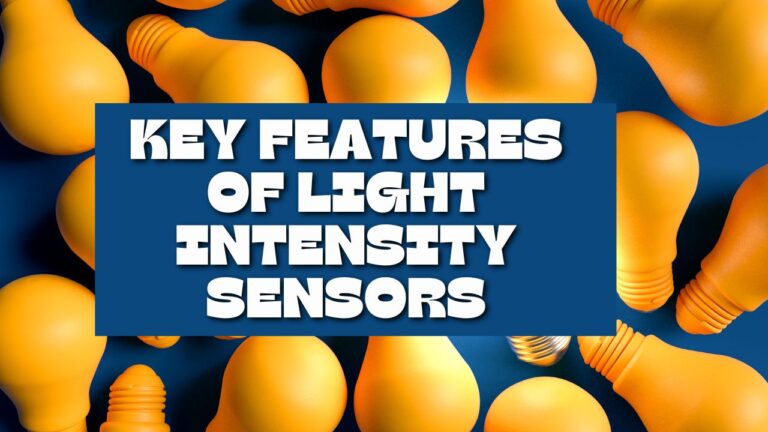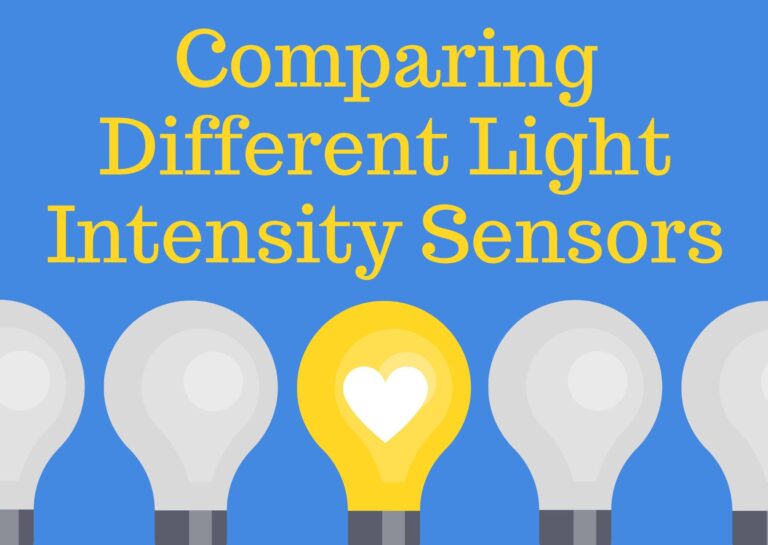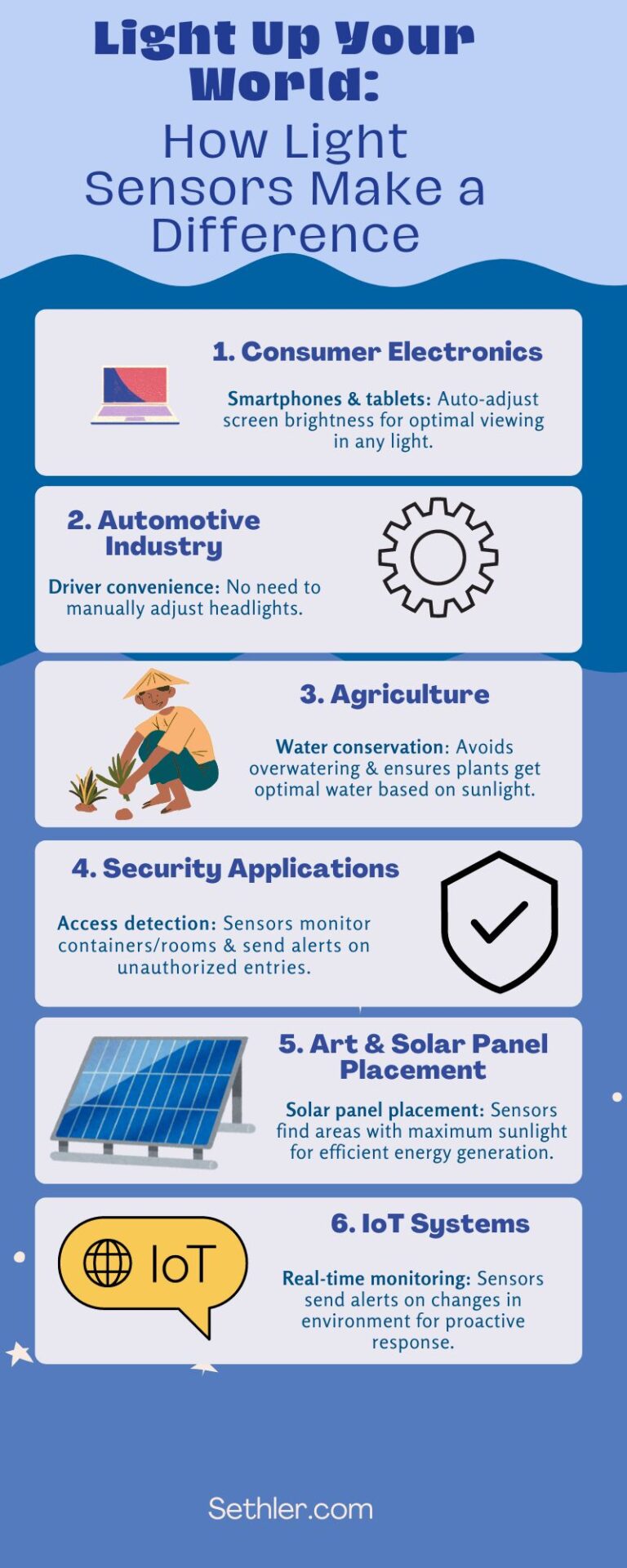Light intensity sensors are devices used to measure the level of light in a given setting. These sensors work by converting energy into a signal allowing for accurate and precise measurements of light, in various settings. They are widely utilized in research, industrial automation and medical equipment to provide data.
In this article we will delve into the realm of light intensity sensors exploring their main characteristics and comparing different types available on the market. Additionally we will examine uses of these sensors such, as detecting placement regulating brightness enhancing security measures aiding in planning processes supporting agriculture practices and more. By the conclusion of this article you will gain insight into selecting the light intensity sensor tailored to your specific requirements – whether it is for measuring photo synthetically active radiation or other light related parameters.
Understanding Light Intensity Sensors
Light intensity sensors, which are also referred to as photodiodes or phototransistors play a role, in converting light into current. These sensors come in three variations;
- Photoconductive Cells: Light Dependent Resistors (LDR) for example adjust their resistance depending on the brightness of the light they receive. LDRs consist of cadmium sulfide cells that are particularly responsive, to near infrared light.
- Photodiodes: Photodiodes, crafted from silicon and germanium components include filters, integrated lenses and surface regions. They operate based on the photoelectric effect, which occurs when light beams strike and release electrons generating electron holes that lead to flows. These photodiodes find applications, in gadgets, like cameras and optical communication setups.
- Phototransistors: Phototransistors, which consist of a photodiode and an amplifier exhibit enhanced sensitivity compared to photodiodes. However they are not as effective, in detecting low light conditions. These devices find applications, in position sensing and security systems.
Light sensors can detect the intensity of light across a specific range of wavelengths, including:
- Full spectrum of visible light
- Ultraviolet light
- Infrared light
- Sunlight
When choosing a light intensity sensor, several factors should be considered:
- Sensitivity
- Response time
- Spectral response
- Linearity
- Operating temperature range
- Package size and shape
Key Features of Light Intensity Sensors

Light intensity sensors come with a range of features and specifications that make them suitable for various applications. Here are some key features to consider:
Sensitivity and Measuring Range:
Different sensors have varying sensitivity levels and measuring ranges. For example:
- The Vernier Light Sensor uses a silicon photodiode and has a 13-bit resolution with sensitivity ranges from 0-600 lux to 0-150000 lux.
- The Yocto-Light (V1) uses an OSRAM SFH-5712 sensor with a measuring range of 3…65’000 lux and sensitivity up to 0…80’000 lux.
- The Yocto-Light-V2 uses an AVAGO APDS-9301 sensor with a measuring range of 0…16’000 lux and sensitivity up to 0…60’000 lux.
- The Yocto-Light-V3 uses a ROHM BH1751FVI sensor with a measuring range of 0…100’000 lux and sensitivity up to 0…120’000 lux.
Compatibility and Interfaces:
Various software and interfaces, like LabQuest, computers, Chromebook, iOS Android, Arduino, LabVIEW and Texas Instruments work well with sensors. This compatibility makes it easy to integrate them into systems and applications seamlessly.
Sensor Types and Applications:
Photodiodes convert light into electrical current and are commonly used in high-speed, low-noise applications.
- Phototransistors have a built-in amplifier that increases the electrical signal produced by the sensor, making them ideal for high sensitivity and low power consumption applications.
- CCD sensors are arrays of photodiodes that convert light into electrical signals and are commonly used in digital cameras, camcorders, and other imaging devices.
- The OPT3002 is suitable for low-power tamper detection due to its wide spectral range from 300nm to 1000nm and low current.
- The OPT3004 and OPT4001 closely match the human eye spectrum and reject > 99% of IR, making them ideal for day and night detection.
- The OPT3005 rejects 99.99+ percent (4+ orders) of Near Infrared (NIR) light over a large angle of incidence, making it ideal for video surveillance applications.
- TI’s OPT4001 is a great choice for display brightness adjustment due to its impressive speed and resolution, and it comes in an ultra-small package for thin bezels.
Light intensity sensors are able to assess light using units, like Lumens (the visible light emitted from a source) Lux (brightness) and Candela (light intensity). They can also measure how far they are from a source, by measuring brightness, which diminishes as the sensor moves away and ascertain the angle of a beam based on brightness.
Comparing Different Light Intensity Sensors

When comparing light intensity sensors there are an important factors to keep in mind. The Yocto Light V2 is great, for measuring low intensity light detecting signals and obstacles measuring the brightness of spectrum lighting and distinguishing between different types of lights like fluorescent/LED and incandescent/daylight in indoor lighting settings. On the hand the Yocto Light V3 is more suitable for measuring light both indoors and outdoors (in lux) and, for any other scenario where the Yocto Light V2 may not be as effective.
Other popular light intensity sensors include:
- Photoresistors (LDRs): Light sensitive resistors adjust their resistance according to the brightness of light. Crafted from cadmium sulfide materials these components exhibit a responsiveness, to both near infrared light wavelengths.
- Photodiodes: These electronic components transform light into electricity. Constructed from silicon or germanium materials they operate based on the photoelectric effect in which light induces the release of electrons leading to the generation of current.
- Phototransistors: A combination of a photodiode and an amplifier, phototransistors provide better light sensitivity than photodiodes.
The Grove series offers several light sensor options, each with its unique features:
- The Grove – Light Sensor v1.1 features a dual OpAmp chip LM358 on board, providing a convertable electrical signal output.
- The Grove – Light Sensor v1.2 is a low-cost option with high sensitivity and reliability.
- The Grove – Digital Light Sensor offers a digital signal output with a selectable light spectrum range and programmable configuration.
- The Grove – Sunlight Sensor is made for direct sunlight detection with UV, suitable for a variety of other light sources as well.
Practical Applications of Light Intensity Sensors
Light intensity sensors are utilized in a range of industries, including consumer electronics, agriculture and security. Let’s explore some real world scenarios where these adaptable devices come in handy;

Consumer Electronics:
Smartphones and tablets make use of sensors to automatically adjust screen brightness providing the visibility, under varied lighting conditions.
Light sensors are employed in proximity sensors to identify objects, like when a phone’s placed near the users face during a call.
Automotive Industry:
The light sensors help drivers see better by sensing the light, around them and turning on the cars lights automatically when its dark. This function improves safety.
Makes it easier for drivers to see without having to adjust the lights themselves.
Agriculture:
Farmers use sensors to improve their watering routines by identifying the sunlight intensity and turning on irrigation systems when the sun is not shining brightly. This method helps in using water avoiding watering and guaranteeing that plants get the appropriate amount of water according to the sunlight present.
Security Applications:
Light sensors are capable of identifying access, to containers or rooms by recording each instance the container is opened, sending out notifications when unexpected environmental shifts occur.
Within cargo transports light sensors integrated with circuits can be inserted into containers to oversee any openings that may occur during the journey.
Additionally light sensors play a role, in security setups to spot entries by detecting alterations in the surrounding conditions.
Art and Solar Panel Placement:
Museums can use light sensors to locate art appropriately, avoiding areas with harsh sunlight that could damage sensitive paintings and photographs.
In solar panel installations, light sensors can optimize the positioning of panels to maximize their exposure to sunlight, thereby increasing energy efficiency.
IoT Systems:
Light sensors are commonly incorporated into Internet of Things (IoT) setups to cut down on energy expenses minimize pollution and pinpoint risks.
These sensors have the ability to send out notifications upon detecting shifts making them crucial elements, in intelligent buildings and businesses.
These examples merely scratch the surface of how light intensity sensors are harnessed in fields. With progress the uses of these sensors are broadening, facilitating efficiency, safety and convenience in various sectors.
Choosing the Right Light Intensity Sensor
When selecting a light intensity sensor for your application, consider the following key factors to ensure optimal performance and compatibility:
Sensor Specifications:
- Sensitivity: Find out the sensitivity range needed by considering the levels expected in your scenario. Greater sensitivity enables measurements, in dim lighting situations.
- Rise Time: When looking at a sensors reaction time or rise time it’s important to note how swiftly it can pick up on shifts, in levels. Quick rise times are essential for tasks that demand reactions, like capturing moving subjects, in photography or detecting motion accurately.
- Quantum Efficiency: Assess the sensors quantum efficiency, which indicates how well it transforms light into signals. A greater quantum efficiency leads to a signal, to noise ratio and enhanced precision.
- Operating Temperature: Make sure that the sensors temperature range aligns, with the conditions in which you plan to use it. Certain sensors might not work well in high or low temperatures.
Mounting and Integration:
- Mounting Styles: Different types of light intensity sensors are available, with ways of installation such as Surface Mount Technology (SMT) and Through Hole Technology (THT). SMT sensors are great for designs and automated assembly whereas THT sensors provide enhanced stability and are good, for manual soldering.
- Compatibility: Make sure that the sensors interface and communication protocol work well, with your hardware and software configuration. Typical interfaces to consider are voltage output, I2C and SPI.
Regulatory Compliance:
- RoHS Compliance: If you are developing an application, for the market make sure that the light intensity sensor meets the requirements of the Restriction of Hazardous Substances (RoHS) directive. Sensors that are RoHS compliant do not contain substances, like lead, mercury and cadmium.
- Certifications: Make sure to look into any certifications or standards that are important, for your industry or specific use case like ISO, UL or CE. These certifications guarantee that the sensor complies with safety and performance criteria.
By taking into account these factors and aligning them with the requirements of your application you can choose the optimal light intensity sensor that provides precise readings all while adhering to regulations and integration criteria.
Conclusion
Light Intensity sensors that measure the intensity of light have become tools in an array of fields, including consumer electronics, automotive, agriculture and security. These sensors work by converting energy into signals allowing for precise and reliable measurements of light levels. They help in making decisions and automating processes. Different types of sensors, like photodiodes, phototransistors and LDRs offer varying levels of sensitivity, response time and spectral requirements.
When choosing a sensor for a purpose it’s important to consider factors like sensitivity, response time, efficiency in capturing light particles (quantum efficiency) and temperature range within which it operates. Ensuring that the sensor is compatible with existing hardware and software systems while meeting industry standards and regulations is crucial for integration and dependable performance. With technology advancing these light sensors are poised to play a role, in shaping the future of multiple industries by fostering innovation and enhancing efficiency.


I truly savored what you’ve accomplished here. The sketch is elegant, your authored material trendy, however, you seem to have developed some trepidation about what you aim to offer next. Certainly, I shall revisit more regularly, just as I have been doing nearly all the time, in case you uphold this ascension.
Thank you for your words! I’m happy to hear that you enjoyed the article. Found the visuals captivating. It’s true I’m always looking ahead in the field of sensor technology. The possibilities are endless and, with potential applications and advancements, on the horizon it can sometimes feel a bit overwhelming! Currently I’m focusing on detailing the types of sensor technology within each category. Once I’ve covered all the types comprehensively I’ll shift my attention towards exploring real world applications and case studies of developments. Stay connected with us as we embark on this journey—its going to be a lot of fun!
I truly relished the effort you’ve invested here. The design is tasteful, your authored material fashionable, however, you seem to have acquired some unease about what you intend to present henceforth. Undoubtedly, I’ll revisit more regularly, similar to I have nearly all the time, in the event you sustain this rise.